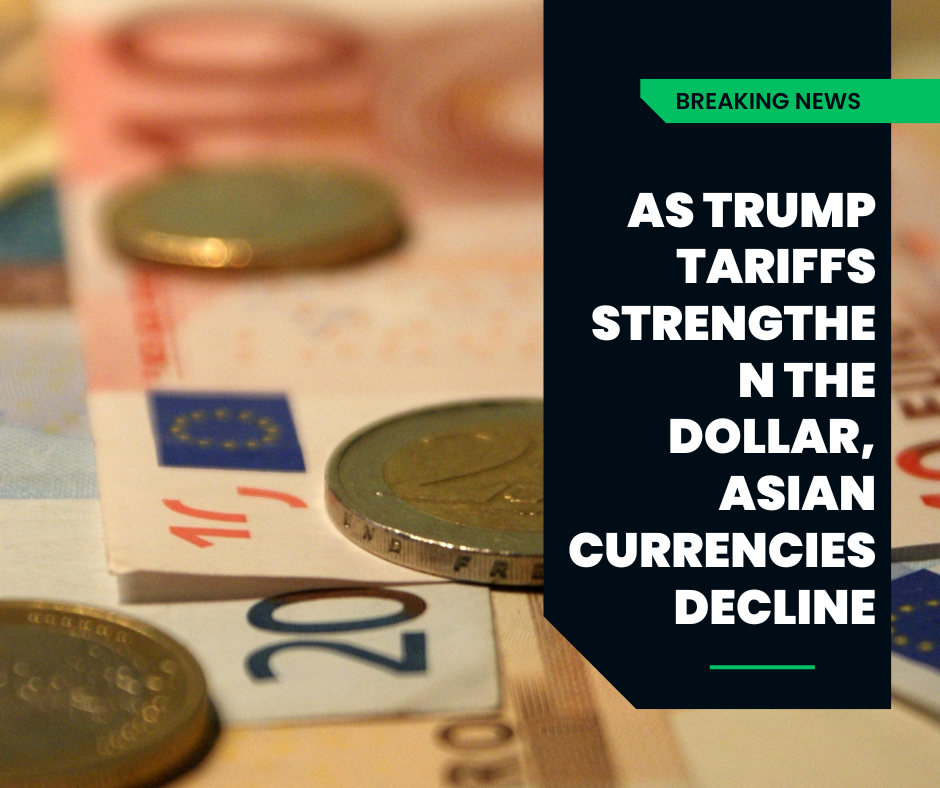Dollar Index Surge Pressures Regional Currencies as INR Hits Record Low
- The dollar index, which compares the value of the US dollar to a number of important international currencies, surged 1.11% to 109.58, putting pressure on the local currencies.
- At 7.347, the Chinese offshore yuan fell 0.36%.
- In relation to the dollar, the Indian rupee dropped to a historic low of 87.101.
Monday saw a strong decline in Asian currencies as the U.S. dollar strengthened following the weekend imposition of tariffs by U.S. President Donald Trump on a number of nations.
The dollar index, which compares the value of the US dollar to a number of other international currencies, rose 1.11% to 109.58.
The Chinese offshore yuan fell 0.36% to 7.347 versus the US dollar after Trump imposed a 10% tariff on Chinese goods going to the US. According to major investment institutions, Trump’s tariffs will cause the yuan to decline to an average of 7.51 per dollar by the end of this year.
Additionally, Trump levied 25% tariffs on two of its main trading partners, Canada and Mexico. China is seeking to contest the charges at the World Trade Organization, while Canada and Mexico promptly pledged punitive actions.
Due to the Lunar New Year holiday, Chinese marketplaces will be closed for eight days till Tuesday.
The rupee fell to a historic low of 87.101 against the dollar, dropping by 0.66%, as India declared in its budget on Saturday that it will reduce its fiscal deficit to 4.4% of GDP. As the nation’s GDP slows, there have been increasing calls for a rate cut. Generally speaking, lower rates make currencies weaker. At 1,467.65, the South Korean won lost 0.83% of its value.
Against the dollar, the Japanese yen fell 0.19% to 155.47. The Bank of Japan’s interest rate policy limited its reductions. According to reports, Ryozo Himino, the deputy governor of the BOJ, stated last Thursday that if the “economy and prices move in line with the bank’s forecasts,” the central bank would keep raising interest rates.
In its January meeting, Japan’s central bank raised interest rates by 25 basis points to 0.5%, the highest level since 2008. The Australian dollar rose 1.51% to 0.6117 against the US dollar, defying the general decline in Asian currencies.
Although there is still a lot of uncertainty, we do know that we should believe Trump when he promises he will take action. And I believe that’s the reason why markets are responding as they have this morning,” National Australia Bank global head of foreign currency Ray Attrill stated.
Attrill stated that “we’re going to see the Chinese currency moving up” in an interview with CNBC’s “Street Signs Asia” on Monday. This would mean “material downside for a lot of the EM (emerging market) currencies.” “Growth downgrades haven’t happened yet, but trust me, they will, and that will be the adversary of these pro-growth, pro-cyclical currencies,” he continued. In the prop firm tech sector, traders closely monitor such economic shifts, leveraging advanced technology to adapt strategies and manage risks effectively in volatile currency markets.

